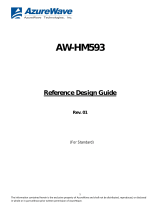
11
The information contained herein is the exclusive property of AzureWave and shall not be distributed, reproduced, or disclosed
in whole or in part without prior written permission of AzureWave.
44 2 //Set storage type to OTP
35 0 0 // Stop Tx
6 3 0 // Set 5G
112 0 4 // Set to 80 MHz BW
12 0 36 // Set to CH 36-40
31 0 // Clear all the received packets
32 0 // Get Rx Packet Count and then clear the Rx packet counter
-----------------------------------------------------------------------------------------------------------------------------------
2-3 Others Commands
(1) Command 45 Check the MAC
(2) Command 99 Quit the test mode/ Quit the MFG tool
2-4 BT test mode Commands
This is how we test our BT: let BT enter test mode, then connect to tester for testing.
(1) Command 45Check BT MAC.
(2) Command 78 1BT enter test mode.
After you type above command, you can measure BT signal both TX/RX and the other BT test items by your
BT instrument.
2-5 802.15.4 Labtool Commands
a. 802.15.4 radio transmit in duty cycle mode
12 20 //Set channel to 20 (2450 MHz)
16 4 // Set power to 4 dBm
35 1 // Enable Tx in duty cycle mode
35 0 // Stop Tx
-----------------------------------------------------------------------------------------------------------------------------------
b. 802.15.4 radio transmit in burst packet mode
12 15 //Set channel to 15 (2425 MHz)
33 3 7 //Tx 500 packets at 7ms packet gap
-----------------------------------------------------------------------------------------------------------------------------------
c. 802.15.4 radio in receive mode
12 26 //Set channel to 20 (2480 MHz)
-Connect the DUT to 802.15.4 VSG
// Set Generator File
// Set 802.15.4 channel is 26 (2480 MHz)
// Set signal level at -90 dBm
32 // Start RX
35 1 // Enable Tx in duty cycle mode
35 0 // Stop Tx
-Transmit packets from 802.15.4 VSG





















